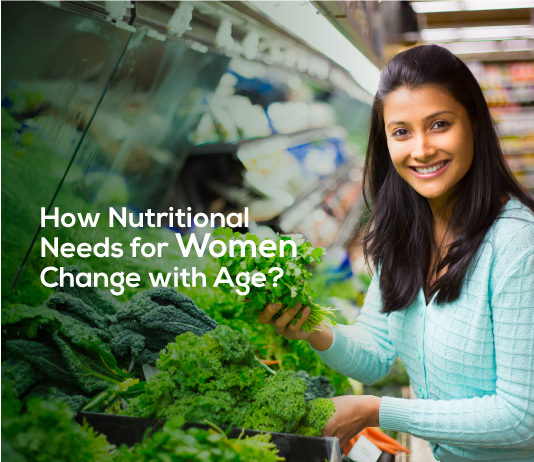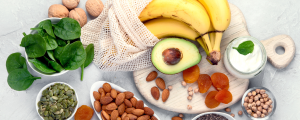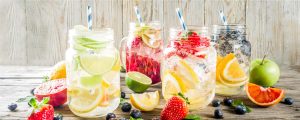As children, nutritional needs for boys and girls are mostly similar. However, with the onset of puberty, nutritional requirements for women change drastically. Furthermore, as we age, the nutritional needs of the body evolve with many other functional and bodily changes.
The modern woman is a multi-tasker, an over achiever and an active player in the game of life. This hectic and sometimes tiring schedule can make it difficult for any woman to maintain a healthy diet. Hormonal changes associated with menstruation, childbearing, and menopause mean that women have a higher risk of anemia, weakened bones, and osteoporosis, requiring a higher intake of nutrients such as Iron, Calcium, Magnesium, Vitamin D, and Vitamin B9 (folate).
Here is how Women’s nutritional needs change with age –
In your teens
Adolescence is a unique period that represents immense biological and socio-emotional development for women. It is associated with a series of hormonal changes that result in sexually mature adults.
Due to the rapid physical growth, physiological activities are increased, and they need more energy to meet increasing demands. However, adolescent girls are at risk of malnutrition (underweight, micronutrient deficiencies).
Deficiencies of Iron among adolescent girls are highly prevalent and can affect more than 30% [1][2][3] of adolescent girls. Similarly, Vitamin A deficiency was found to be 20% among adolescent girls [4]. Nutritional deficiencies during adolescence can have long-term consequences, including delayed sexual maturation, loss of final adult height, and osteoporosis.
Adequate intake of protein is vital for adolescence. Vitamins and minerals such as Calcium, Iron, and iodine must be included in an adolescent girl’s diets.
Include these foods in your diet to harness your #TruePotential:
- Protein
Proteins are essential for muscle mass and tissue repair.
Food Sources: Lean meat, poultry, and fish, eggs, dairy products like milk, yogurt, and cheese, pulses are the good sources of protein.
- Calcium
Calcium is the principal mineral that strengthens bones and is very important when adolescents are going through their skeletal growth phase.
Food Sources: milk, cheese, and other dairy foods, broccoli, cabbage, and okra.
- Iron
Deficiencies of Iron among adolescent girls are highly prevalent. Anemia in adolescence causes reduced physical and mental capacity and diminished concentration in work and educational performance.
Food Sources: Animal-based foods are the best source of Iron, especially red meat. Chicken, eggs, fish, spinach, and broccoli are also good sources of Iron.
- Vitamin A
It plays an important role in egg development.
Food Sources: Cod liver oil, eggs, orange, and yellow vegetables and fruits
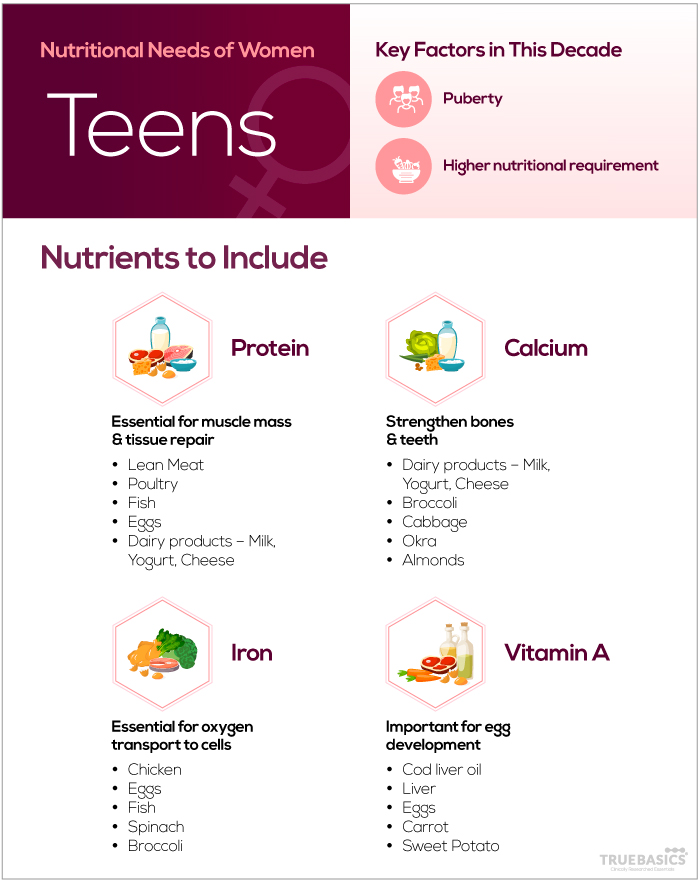
In your 20s
Young adults, in their early 20s, transition from adolescence to adulthood and are potentially vulnerable to weight gain. It has been observed that the greatest increase in obesity (BMI > 30) was found amongst young adults between the ages of 18–29 years (7.1–14%) [5].
Based on the survey, 60% of young adult groups are eating an inadequate amount of fruits and vegetables and 41% eating meals irregularly [6]. Due to this dietary behavior and consuming fast food regularly further increases the chance of obesity. Lack of fiber in the diet and high total fat induces obesity.
Fast foods are rich in unhealthy fat and lower in dietary fiber, Calcium, and Iron than home-made foods. In addition, Calcium and Iron are important elements during this period of development for an increase in lean body mass and skeletal growth.
Therefore, healthy dietary behaviors are needed that can prevent the risk of obesity and overcome the nutritional deficiencies due to increased intake of junk food by this age group.
Include these foods in your diet to harness your #TruePotential:
- Fiber
Fiber is important for metabolism and nutrient absorption.
Food Sources: Wholegrain bread and oats, barley and rye, fruits such as berries, pears, melon, and oranges. Vegetables such as broccoli, carrots and sweetcorn, peas, beans, and pulses. - Calcium
Calcium helps to strengthen bones.
Food Sources: Milk, cheese, and other dairy foods, broccoli, cabbage, and okra. - Iron
Iron is an integral part of hemoglobin which is essential for oxygen transport to cells and the production of red blood cells.
Food Sources: Animal-based foods are the best source of Iron, especially red meat. Chicken, eggs, fish, spinach, and broccoli are also good sources of Iron. - Iodine
The young adult women are future mothers; iodine deficiency in them can affect the newborns, resulting in neonatal hypothyroidism. Iodine is a trace element (micronutrient) that plays a vital role in the synthesis of thyroid hormones that are crucial for growth and development.
Food Sources: Iodized salt, fish such as cod and tuna, seafood, eggs, shrimp.
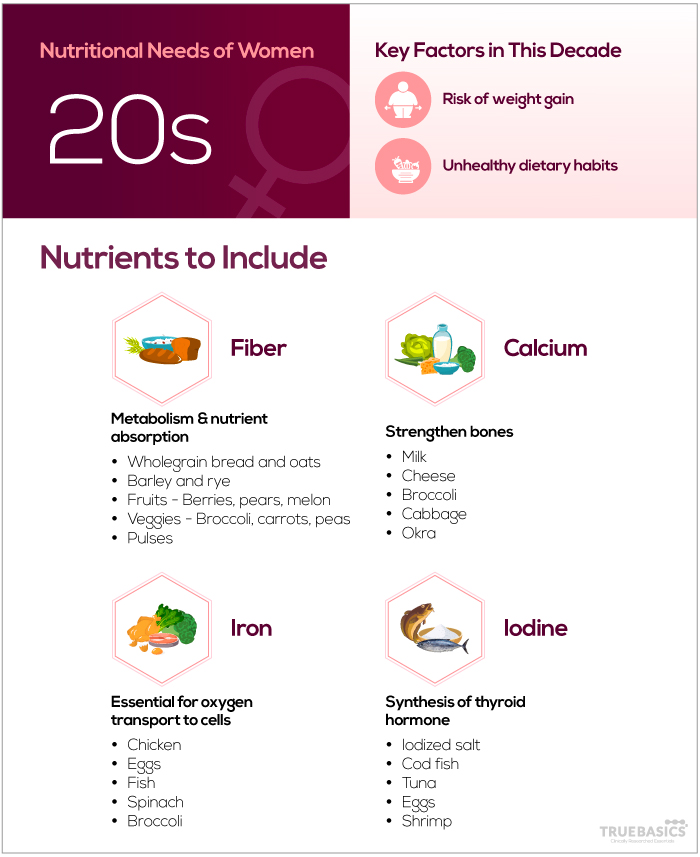
In your 30s
Good sexual and reproductive health is important for women’s general health and wellbeing in their late 20s and early 30s. Unfortunately, the fertility of women starts to decrease from the mid-20s onwards due to estrogen imbalance.
An unbalanced caloric and protein intake due to incorrect food consumption, responsible for severe under- or overweight, leads to alterations of the ovarian function with subsequent increase in infertility. Moreover, nutritional factors may influence not only oocyte maturation but also the quality of embryos and the efficiency of implantation.
During this age, women are most active at their workplace and household chores. This increases their energy demand significantly. Coupled with declining physical strength, it takes a toll on their health.
A correct balance of proteins, carbohydrates, lipids, antioxidants, Vitamins, and minerals in the daily diet provides essential benefits for optimal female reproductive health, reduces the risk of infertility and provides adequate energy for daily activities.
Include these foods in your diet to harness your #TruePotential:
- Fiber
Fiber is important for metabolism and nutrient absorption.
Food Sources: Wholegrain bread and oats, barley and rye, fruits such as berries, pears, melon, and oranges. Vegetables such as broccoli, carrots and sweetcorn, peas, beans, and pulses. - Vitamins
Vitamins play several roles in the body including providing energy, bolstering immunity, repair cellular damage, and convert food into energy.
Food Sources: Leafy vegetables, brown rice, red meat, poultry, fish, eggs, milk, cheese, beans.
- Antioxidant
Antioxidants help in energy production and prevention from free radical damage.
Food Sources: Cranberries, red grapes, cherries, pears, guava, oranges.
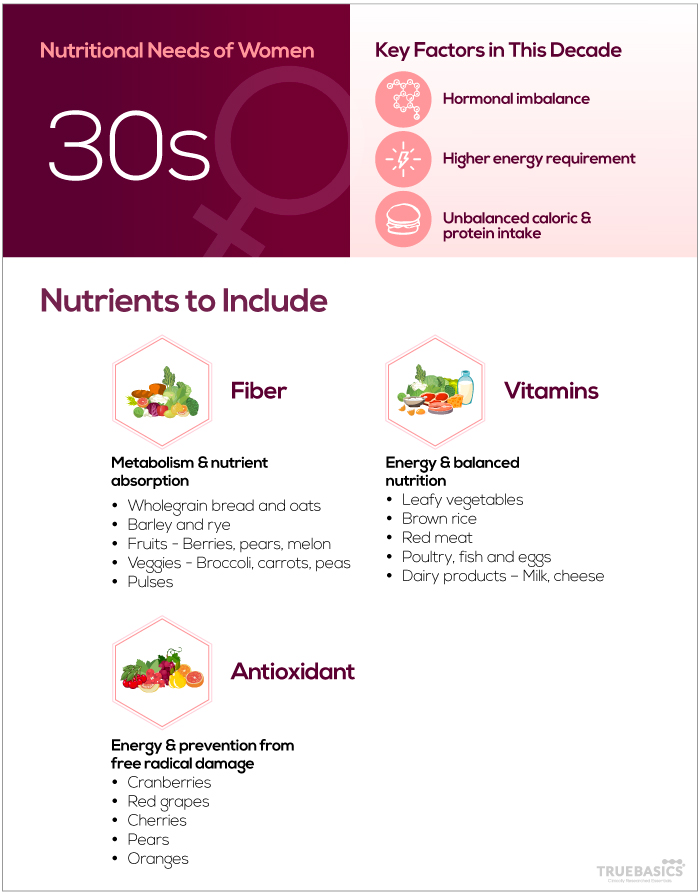
In your 40s
Loss of estrogen production by the ovaries is a major aging process of this age group. This is also known as menopause. This age-dependent natural decline in estrogen causes a progressive decrease of muscle mass and strength and bone density due to its role in Calcium and protein metabolism.
In addition, the decline in estrogen affects the collagen synthesis of the skin that leads to thinning of the skin, decreased elasticity, increased wrinkle formation.
Include these foods in your diet to harness your #TruePotential:
- Protein
Proteins are essential for muscle mass and tissue repair.
Food Sources: Lean meat, poultry, and fish, eggs, dairy products like milk, yogurt, and cheese, pulses are good sources of protein.
- Calcium
Calcium is the principal mineral that strengthens bones and is very important to prevent bone loss due to a decline in estrogen.
Food Sources: milk, cheese, and other dairy foods, broccoli, cabbage and okra.
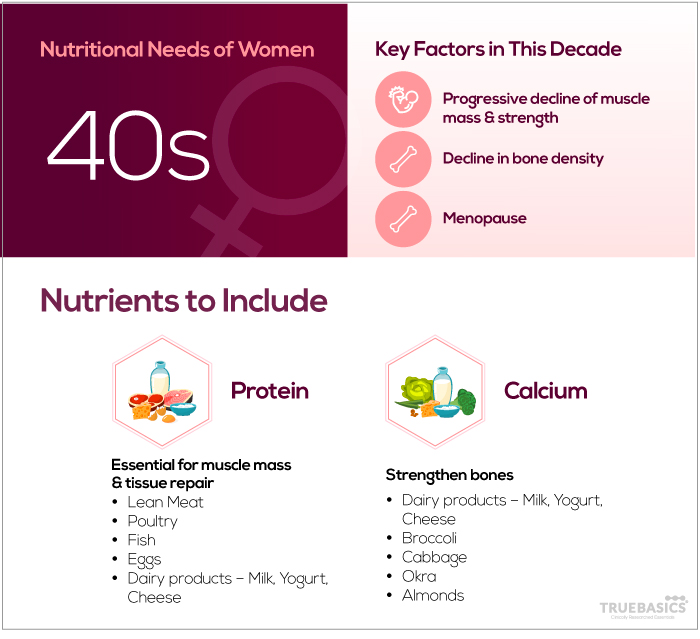
Beyond your 50s
It has been estimated that at least 1 in 3 women over the age of 50 will experience osteoporotic fractures [7] due to a rapid decline in estrogen levels in the blood. Similarly, the loss of muscle mass begins substantially at the age of 50 and continues afterward.
It has widely been found that the volume and weight of the brain decline with age at a rate of around 5% per decade after age 40. These changes in the brain may affect cognitive functions. Diets rich in polyunsaturated fatty acids (PUFA) play multiple roles in improving brain function by influencing neurotransmission, cell survival, and neuroprotection.
In addition, in people aged over 50, age-related macular degeneration (AMD) is the leading cause of irreversible vision loss. Dietary antioxidants are found to be beneficial in decreasing the risk of age-related eye diseases.
Include these foods in your diet to harness your #TruePotential:
- Calcium
Calcium is the principal mineral that strengthens bones and is very important to prevent bone loss due to a decline in estrogen.
Food Sources: Milk, cheese, and other dairy foods, broccoli, cabbage, and okra. - Antioxidant
Antioxidants help in energy production and prevention from free radical damage.
Food Sources: Cranberries, red grapes, cherries, pears, guava, oranges. - Protein
Proteins are essential for muscle mass and tissue repair.
Food Sources: Lean meat, poultry, and fish, eggs, dairy products like milk, yogurt, and cheese, pulses are the good sources of protein. - Fatty Acids
Fatty acids such as Omega-3 play an important role in maintaining heart, joint, and eye health.
Food Sources: Sunflower seeds, Flax seeds, Fish, such as salmon, mackerel, herring, albacore, Walnuts, Avocado, Chia seeds.
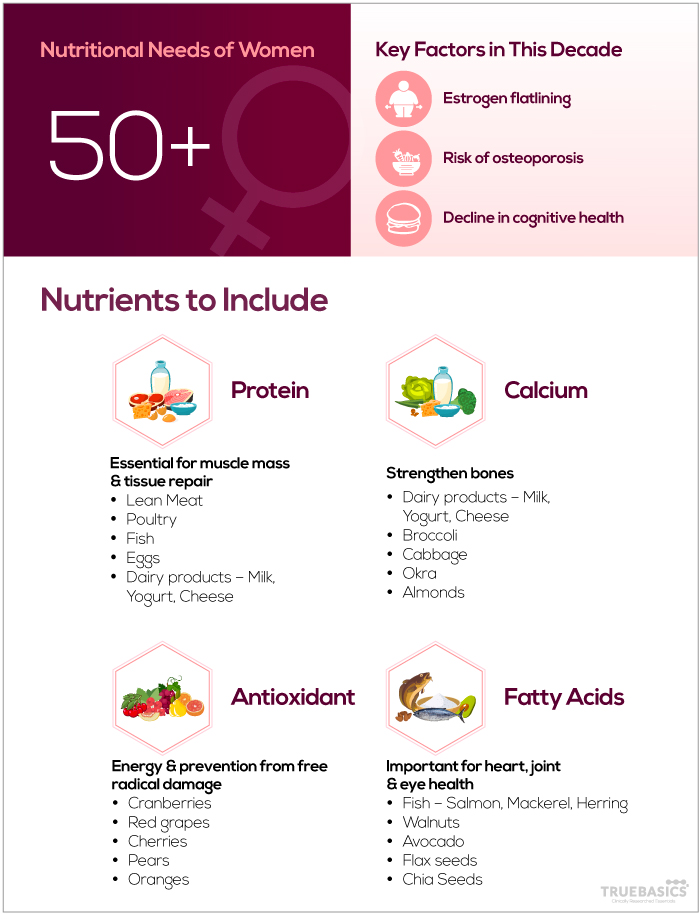
In conclusion…
As children, both sexes tend to have the same dietary requirements while growing up. But after the onset of puberty, nutritional needs change at every stage of a woman’s life.
Adolescents girls are at risk of micronutrient deficiencies and require protein, calcium, and iron to suppose their rapid growth. Young adult females are vulnerable to weight gain due to the change in their dietary patterns. In addition, Calcium and Iron are important elements during this period of development for an increase in lean body mass and skeletal growth.
In the age group of the 30s and 40s, adequate consumption of dietary protein and Calcium are critical for the maintenance of optimal muscle and bone health. While the post-menopausal decline of estrogen in women over 50 makes them prone to osteoporotic fractures and loss of muscle mass. At this stage, fatty acids such as Omega-3 play an important role in maintaining the heart, joint, and eye health.
Women witness many bodily and hormonal changes throughout their life. Their different physiology then men along with multiple life phases such as puberty, pregnancy, and menopause necessitate key changes to their diet and nutrition as well.
#ShareIfYouCare #RepublicofDeficiency
Sources:
[1] https://www.ncbi.nlm.nih.gov/pmc/articles/PMC6315365/?report=classic
[2] https://www.ijmedicine.com/index.php/ijam/article/view/1211
[3] https://www.newsclick.in/Malnourished-Indian-Children-Adolescents-UNICEF-Report
[4] https://www.ncbi.nlm.nih.gov/pmc/articles/PMC6315365/?report=classic
[5] https://www.ncbi.nlm.nih.gov/pmc/articles/PMC2794379/
[6] https://www.ncbi.nlm.nih.gov/pmc/articles/PMC4346025/?report=classic
[7] https://www.iofbonehealth.org/facts-statistics

